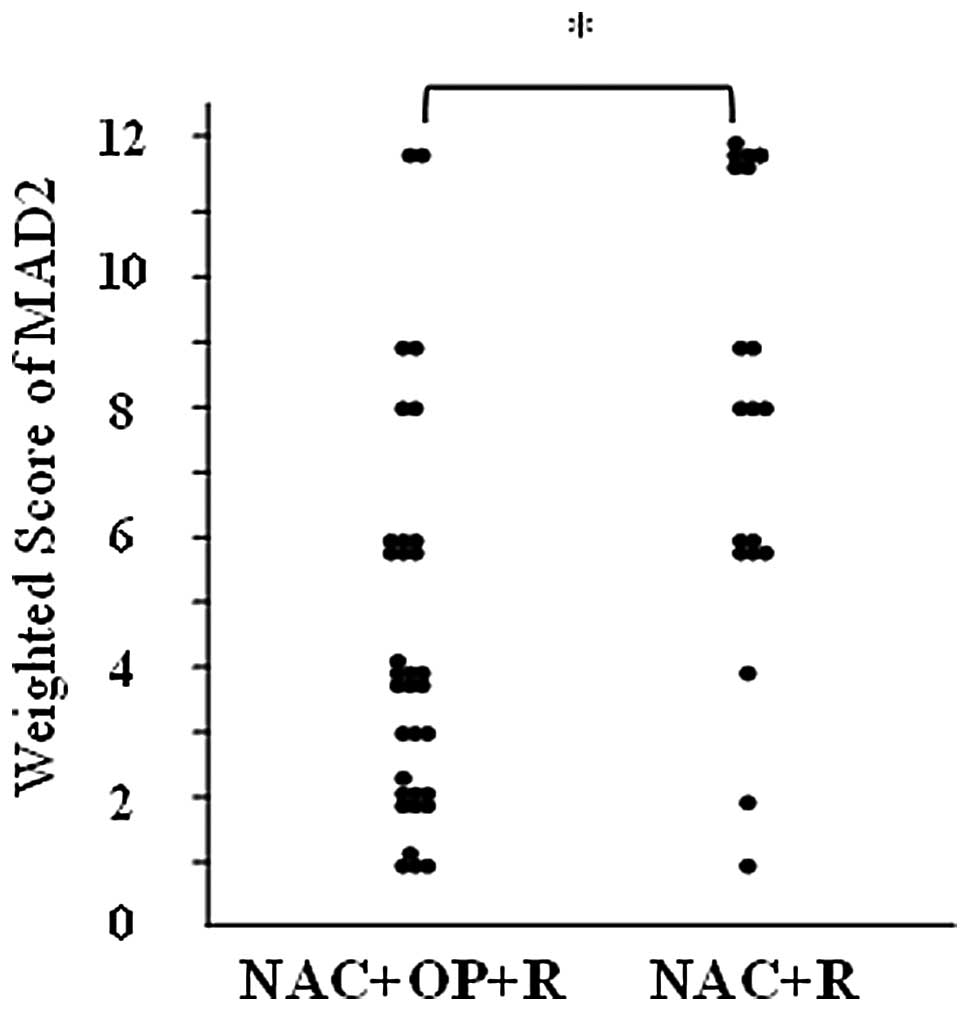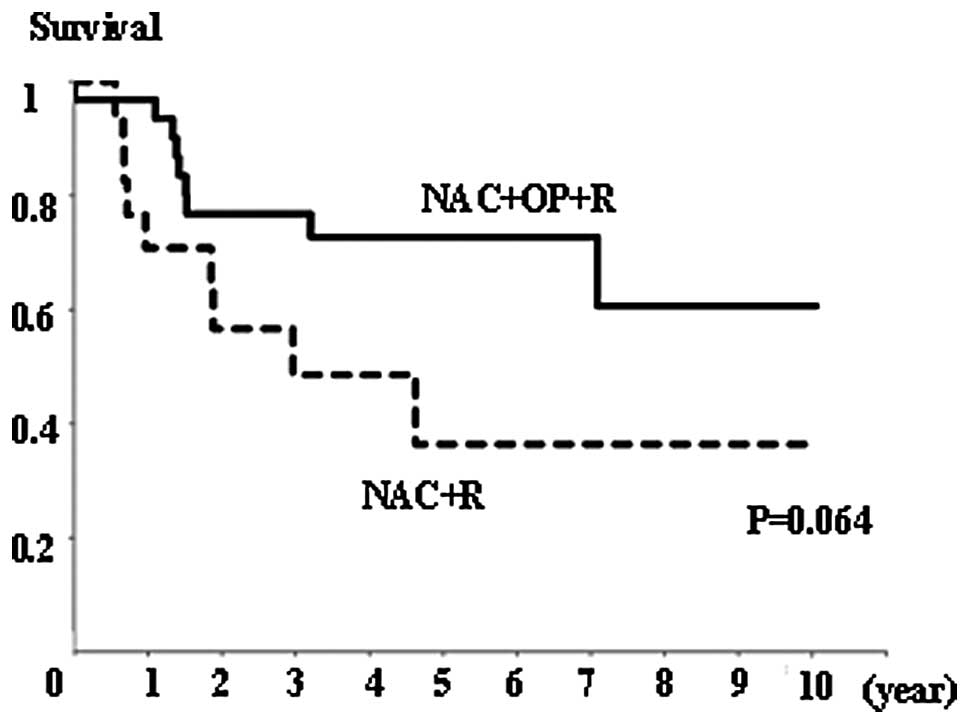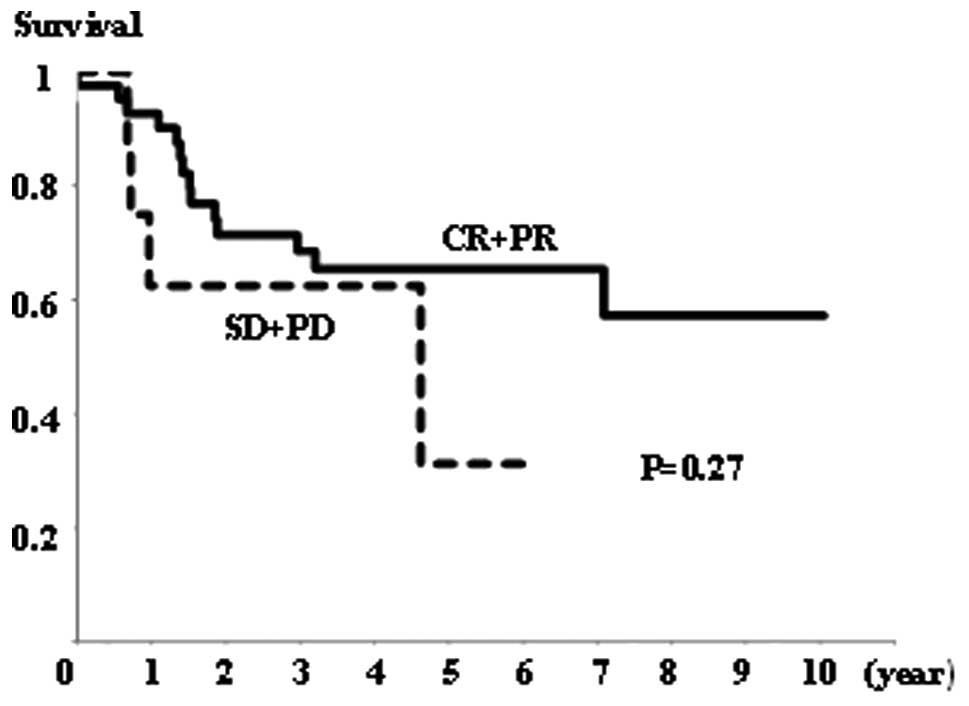Expression of mitotic-arrest deficiency 2 predicts the efficacy of neoadjuvant chemotherapy for locally advanced uterine cervical cancer
- Authors:
- Published online on: December 5, 2011 https://doi.org/10.3892/etm.2011.407
- Pages: 341-346
Abstract
Introduction
Mitotic arrest deficiency 2 (MAD2) was the first gene involved in the mitotic spindle checkpoint pathway to be characterized (1,2). MAD2 localizes on kinetochores following chromosome condensation and prior to anaphase (3), and plays a crucial role in the transition from metaphase to anaphase by inhibiting the anaphase-promoting complex/cyclosome (APC/C). This ensures that all the chromosomes are correctly aligned at the metaphase plate prior to daughter cell segregation (1,4). Therefore, MAD2 is a key component of the mitotic spindle checkpoint pathway, which plays an important role in preventing loss or gain of chromosomes within cells (5). A compromised mitotic spindle checkpoint results in an abnormal number of chromosomes, known as chromosomal instability (CIN) (6). CIN, characterized by an alteration in chromosome number, and commonly detected as aneuploidy (7,8), has been reported in the majority of types of human cancer. Although the underlying molecular mechanisms have yet to be clarified, it is notable that the overexpression of MAD2 in transgenic mice results in CIN, and initiates carcinogenesis in a wide variety of tumors (9). In fact, the overexpression of MAD2 has also been observed in a variety of human cancers (10–20). Certain studies have suggested a correlation between the overexpression of MAD2 and a variety of clinicopathological characteristics, such as histological grade (differentiation), metastasis and prognosis (13–19). However, reduced expression of MAD2 occurs in certain types of human cancer (4,21) and is associated with in vitro resistance to chemotherapy using microtubule-targeting agents or DNA-damaging agents (22,23).
MAD2 expression has not been examined in uterine cervical cancer; a form of cancer that, if advanced, is very difficult to treat. Concurrent chemoradiotherapy (CCRT) is recommended as the standard treatment for locally advanced uterine cervical cancer, such as International Federation of Gynecology and Obstetrics (FIGO) stages IIIa, IIIb and IVa (24,25); however, the prognosis is poor (26,27). Certain studies have reported the use of hysterectomy following successful neoadjuvant chemotherapy (NAC) for locally advanced uterine cervical cancer (28,29), which may control genital bleeding or improve hydronephrosis. However, the prognosis worsens if NAC is unsuccessful, since hysterectomy cannot then be performed and, consequently, the treatment strategy has to be changed from surgery to radiation therapy, resulting in a crucial delay (30,31). Thus, it is important to identify prognostic factors in patients with locally advanced cervical cancer that predict whether NAC is likely to be successful (32–35).
Therefore, the aim of the present study was to examine the correlation between MAD2 expression and the efficacy of NAC for locally advanced uterine cervical cancer.
Patients and methods
Patients and samples
We reviewed 53 cases of locally advanced uterine cervical cancer [stage IIIa and IIIb (FIGO)] initially treated at Osaka City University Medical School Hospital, Japan, from 1995 to 2008 in patients that were under 70 years old. Tumor samples were obtained by biopsy prior to NAC. The cases were divided into two groups: one group in which NAC was effective, surgery was possible and radiation therapy was performed (NAC+OP+R group; n=33), and another group in which NAC was ineffective and, therefore, radiation therapy alone was performed (NAC+R group; n=20) (Table I). Moreover, the cases were further divided into a complete/ partial remission (CR+PR) group and a stable/progressive disease (SD+PD) group according to the measured effects of NAC (Table II). Written informed consent was obtained from all patients prior to immunohistochemical examination and this study was approved by the Ethics Committee of Osaka City University (IRB No.2202).
Balloon-occluded arterial infusion chemotherapy (BOAI) for NAC
Pelvic angiography was performed under local anesthesia using Seldinger’s technique (36) to localize the tumor and feeder vessels. The procedure involves the insertion of a balloon-wedge-single-pressure catheter (5 F, 80 cm in length; Dispomedica, Hamburg, Germany) into each femoral artery, which is then passed into the internal iliac artery. The balloon catheters are then advanced until they reach the vicinity of the feeder vessel (usually the uterine artery), where the balloon is inflated to interrupt the local blood flow. Cis-diamminedichloro-platinum (CDDP) is then slowly infused intra-arterially through the two catheters over a period of 30 min (36). In the present study, the two ovarian arteries were blocked after the first round of BOAI to increase the intratumor concentration of CDDP. BOAI was performed three times to shrink the tumor. Adequate hydration was ensured prior to and following CDDP administration, and antiemetics and diuretics were used as appropriate. CDDP was administered at doses of 50, 75 or 100 mg/m2, depending on the patient’s age and renal function. The efficacy of CDDP arterial infusion therapy was evaluated by cytology, histology, serum tumor marker levels and MRI, prior to the initiation of CDDP treatment. The results were then compared with those obtained following the completion of each arterial infusion. MRI was used to estimate tumor regression by measuring its size in two dimensions (37,38). Tumor tissue was obtained from all patients who had undergone punch biopsy or surgery.
Immunohistochemical analysis
The expression of MAD2 was examined in paraffin-embedded sections using an anti-MAD2 antibody and the avidin-biotin peroxidase complex method. Paraffin sections (4-μm thick) were de-paraffinized and immersed in 3% hydrogen peroxidase in methanol to block endogenous peroxidase activity. An antigen retrieval procedure was then performed by immersing the slides in 10 mM citrate buffer (pH 6.0) and heating in an autoclave at 110°C for 20 min. The sections were then washed in PBS. The protocol supplied with the Dako LSAB 2 peroxidase kit (Dako, Kyoto, Japan) was followed. Sections were incubated with the primary antibody (monoclonal rabbit anti-human MAD2; 1:100; ProteinTech Group, Chicago, USA) for 2 h at room temperature. Sections were then rinsed with PBS for 15 min and incubated for 10 min with the secondary antibody (biotinylated goat anti-mouse and rabbit immunoglobulin G; Dako). The sections were then incubated with the streptavidin-peroxidase complex and 3,3′-diaminobenzidine was used as the chromogen. Finally, the sections were counterstained with Mayer’s hematoxylin. The specificity of the immunohistochemical reactions was checked by omitting the primary antibody. Quantitative analysis of MAD2 expression was based on the scoring method of Sinicrope et al (39). The mean percentage of positive tumor cells was determined in five separate areas (at x400 magnification) and assigned to one of the following categories: 0, <5%; 1, 5–25%; 2, 25–50%; 3, 50–75%; or 4, >75%. The intensity of immunostaining was scored as follows: 1+, weak; 2+, moderate; or 3+, intense. For each specimen, the percentage of positive tumor cells was multiplied by the staining intensity to produce a weighted score.
Statistical analysis
Data were presented as the means ± standard deviation. The Kaplan-Meier and log-rank tests were performed for the prognostic analyses. Weighted scores were compared using the Mann-Whitney U test. The Student’s t-test and χ2 test were performed on a different set of data (age, FIGO stage, histology and main therapy). StatView 5.0 (Abacus Concepts, Berkley, CA, USA) was used for data analysis. P<0.05 was considered to indicate a statistically significant difference.
Results
Patient characteristics
We reviewed 53 cases of locally advanced uterine cervical cancer and divided them into two groups: NAC+OP+R (n=33) and NAC+R (n=20). The mean age of the NAC+OP+R group was 46.2 years (range, 22–69), and that of the NAC+R group was 54.2 years (range, 37–67). The cases in the NAC+OP+R group were classified as stage IIIa (n=1) and stage IIIb (n=32), and the cases in the NAC+R group were classified as stage IIIb (n=20). According to histological type, the cases in the NAC+OP+R group were classified as squamous cell carcinoma (n=29) and adenocarcinoma (n=4), and the cases in the NAC+R group were classified as squamous cell carcinoma (n=18), adenocarcinoma (n=1) and other (n=1; glassy cell carcinoma). There was no significant difference between the two groups (Table I).
Expression of MAD2
MAD2 was expressed in the nuclei of the tumor cells (Fig. 1). The weighted scores are shown in Table III. The mean weighted score for the NAC+OP+R group was 4.5, while that for the NAC+R group was 8.2. MAD2 expression was significantly higher in the NAC+R group compared to the NAC+OP+R group (P<0.001; Fig. 2). The weighted scores were classified as follows: 0, 1 and 2, low expression; 3, 4 and 6, medium expression; and 8, 9 and 12, high expression. In the NAC+OP+R group, 33.3% of the cases (n=11) showed low expression, 48.4% (n=16) medium expression and 18.2% (n=6) high expression. In the NAC+R group, 10% of the cases (n=2) showed low expression, 30% (n=6) showed medium expression and 60% (n=12) showed high expression.
Correlation between expression of MAD2 and effects of NAC
All cases (n=53) were classified into two groups according to the measured effects of NAC: CR+PR (n=41) and SD+PD (n=12) (Table II). The mean weighted score for the CR+PR group was 4.9, while that for the SD+PD group was 9.3 (Table IV). MAD2 expression was significantly higher in the SD+PD group than in the CR+PR group (P<0.01; Fig. 3).
Survival
There was no significant difference in overall survival rates between the NAC+OP+R and NAC+R groups (Fig. 4), or between the CR+PR and SD+PD groups (Fig. 5). However, the NAC+R group tended to show a worse prognosis than the NAC+OP+R group (P=0.064; Fig. 4). Regarding the extent of MAD2 expression, there was no significant difference in overall survival between any of the groups (data not shown).
Discussion
The results of the present study show that the overexpression of MAD2 correlates with ineffective NAC for locally advanced uterine cervical cancer. MAD2 expression was significantly higher in the SD+PD and NAC+R groups. (Figs. 2 and 3). In addition, our results agree with those presented in previous studies showing that prognosis is worse when NAC is unsuccessful (30,31).
In general, CCRT is recommended as the standard treatment for locally advanced uterine cervical cancer, such as FIGO stages IIIa, IIIb and IVa (24,25); however, the prognosis following treatment is not good (26,27). Certain studies have reported on the usefulness of hysterectomy following successful NAC for locally advanced uterine cervical cancer (28,29), which may improve prognosis and control genital bleeding and/or improve hydronephrosis. However, hysterectomy after NAC is not recommended at present, since the prognosis becomes worse if NAC is not successful (30,31). This may be due to a delay in curative treatment, or cross-resistance to radiotherapy. Hence, it is crucial to identify prognostic factors that predict the likely efficacy of NAC in patients with locally advanced cervical cancer (32–35).
MAD2 is a key component of the mitotic spindle checkpoint pathway, which, if compromised, results in CIN and tumorigenesis. The overexpression of MAD2 has been shown to promote aneuploidy, tumorigenesis and tumor progression in mice (19). The overexpression of MAD2 has also been observed in a number of types of human cancer (10–20) and appears to correlate with a variety of clinicopathological characteristics, such as metastasis and prognosis (13–19). Reduced expression of MAD2 has also been reported in certain human cancers (4,21) and is associated with resistance to chemotherapy using microtubule-targeting agents or DNA-damaging agents (22,23).
The present study is the first to report a correlation between MAD2 expression and locally advanced uterine cervical cancer. The data show that MAD2 expression was significantly higher in the NAC+R and SD+PD groups than in the NAC+OP+R or SD+PD groups. This suggests that MAD2 expression is capable of predicting the efficacy of NAC for locally advanced uterine cervical cancer. We speculate that the overexpression of MAD2 induces resistance to chemotherapy; however, other in vitro studies have shown that the decreased expression of MAD2 mediates resistance to chemotherapy (22,23). This discrepancy may be explained by the fact that the overexpression of MAD2 appears to be involved in tumor progression, which may be attributed to resistance to chemotherapy. Also, it is difficult to compare the criteria used to judge whether MAD2 expression was high or low in each study. There are differences in the degree of MAD2 expression between tumors and differences in the measurement methods used (4,10–19,21).
In terms of overall survival rates, a number of studies have indicated that the overexpression of MAD2 is a risk factor for poor prognosis (13–19). The data presented in the present study are inconsistent with this, and show no correlation between MAD2 expression and prognosis (data not shown).
As mentioned above, unsuccessful NAC for locally advanced uterine cervical cancer leads to a worse prognosis. Therefore, factors predicting the effectiveness of NAC will play a critical role in trials of NAC for locally advanced uterine cervical cancer. The results of the present study show that MAD2 expression correlates with resistance to cisplatin-based chemotherapy and may be a strong predictor of the efficacy of NAC.
Acknowledgements
We thank the gynecologists at Osaka City University Medical School Hospital for their support. This study was supported by the Osaka Medical Research Foundation for Incurable Diseases.















